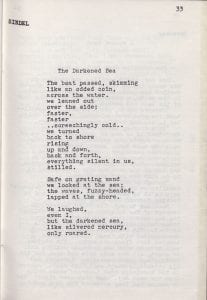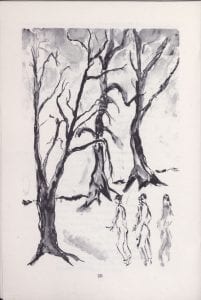That’s no Moon!: The Story of Endor and its Link to Modern Culture
 The Endor magazine, published at Lehigh University from 1959 to 1966, has had a profound effect on campus culture into the modern day. It also links Lehigh to some of the biggest names in popular culture. From faculty members who changed their fields to parents of actors, the Endor saw its share of famous names. It started as a publication “to fulfill the need for a literary journal on the Lehigh campus.” The magazine, which focused on more serious art and literature, started a movement for the arts on Lehigh’s campus during a time when the arts were looked down upon by a large majority of engineers on campus.
The Endor magazine, published at Lehigh University from 1959 to 1966, has had a profound effect on campus culture into the modern day. It also links Lehigh to some of the biggest names in popular culture. From faculty members who changed their fields to parents of actors, the Endor saw its share of famous names. It started as a publication “to fulfill the need for a literary journal on the Lehigh campus.” The magazine, which focused on more serious art and literature, started a movement for the arts on Lehigh’s campus during a time when the arts were looked down upon by a large majority of engineers on campus.
With its inception in 1959, Endor: A magazine of the arts was created to give students an output for their creativity and avoid the  downfalls of the “staff-written” literary magazines of previous years. It also sought to avoid becoming a humor magazine, distinguishing itself from previous Lehigh publications such as the Burr. By the second issue in 1960, it had already gained traction on campus due to its wide variety of writers and represented fields. One article in the Brown and White reported that “When a finance professor (Eli Schwartz) contributes a witty poem, when an authority on 17th century English literature (Ray Armstrong) contributes an excellent short story, and when a music professor (Jonathon Elkus) contributes a provocative essay on contemporary jazz, then, indeed, Endor fulfills a most important function of a university – the extracurricular exchange of creative thinking and artistry.” This began to bring back the mission of a well rounded “gentleman” engineer that Asa Packer had envisioned when he created Lehigh University.
downfalls of the “staff-written” literary magazines of previous years. It also sought to avoid becoming a humor magazine, distinguishing itself from previous Lehigh publications such as the Burr. By the second issue in 1960, it had already gained traction on campus due to its wide variety of writers and represented fields. One article in the Brown and White reported that “When a finance professor (Eli Schwartz) contributes a witty poem, when an authority on 17th century English literature (Ray Armstrong) contributes an excellent short story, and when a music professor (Jonathon Elkus) contributes a provocative essay on contemporary jazz, then, indeed, Endor fulfills a most important function of a university – the extracurricular exchange of creative thinking and artistry.” This began to bring back the mission of a well rounded “gentleman” engineer that Asa Packer had envisioned when he created Lehigh University.
The Endor acts as a reminder of many famous names in Lehigh University history. Mentioned in the above quote, Jonathon Elkus was a music professor at Lehigh who became well known as a concert band composer and director. He eventually won the Edwin Franko Goldman Memorial Citation for his work. Elkus is also remembered for his work as the Director of the Marching 97. Another famous member of Lehigh’s past who is immortalized in the Endor is Professor James R.  Frakes, assistant professor of English. In 1961, when the Endor was having a staffing problem, he stepped up as the faculty adviser for the magazine. James Frakes is probably better known to many as the father of actor Jonathan Frakes, who most famously portrayed Commander William T. Riker in Star Trek: The Next Generation. It is interesting that he would publish in a magazine named Endor, which is now known as a moon in the Star Wars universe instead of the ancient village in Galilee for which the magazine is named.
Frakes, assistant professor of English. In 1961, when the Endor was having a staffing problem, he stepped up as the faculty adviser for the magazine. James Frakes is probably better known to many as the father of actor Jonathan Frakes, who most famously portrayed Commander William T. Riker in Star Trek: The Next Generation. It is interesting that he would publish in a magazine named Endor, which is now known as a moon in the Star Wars universe instead of the ancient village in Galilee for which the magazine is named.
The Endor was able to increase the presence of the arts on campus despite its end in 1966. Poetry readings were  increasing in attendance and prose reading was becoming more common. Professor Frakes was known for reading “poetry that conveys a ‘beat attitude of revolt and protest'” and believed beat or ‘beatnik’ poetry would be representative of the ’60s and 70’s. This brings us to the modern Lehigh setting, where open mic nights, concerts, and performances of all kinds can be found on campus and in Bethlehem. It is regrettable that the publication of such magazines will never have the appeal it once had due to the rise of the Internet. However, we now live in a world where all ideas and pieces of art can be shared despite there being fewer formal outlets, which may mean that our campus is looking forward to a cultural golden age.
increasing in attendance and prose reading was becoming more common. Professor Frakes was known for reading “poetry that conveys a ‘beat attitude of revolt and protest'” and believed beat or ‘beatnik’ poetry would be representative of the ’60s and 70’s. This brings us to the modern Lehigh setting, where open mic nights, concerts, and performances of all kinds can be found on campus and in Bethlehem. It is regrettable that the publication of such magazines will never have the appeal it once had due to the rise of the Internet. However, we now live in a world where all ideas and pieces of art can be shared despite there being fewer formal outlets, which may mean that our campus is looking forward to a cultural golden age.
All publications of the Endor are now available alongside Lehigh’s other student publications on the Internet Archive. Endor will also soon be available on the Lehigh Preserve.